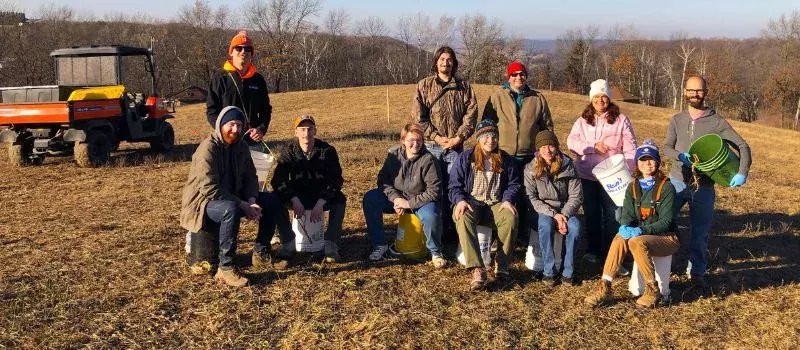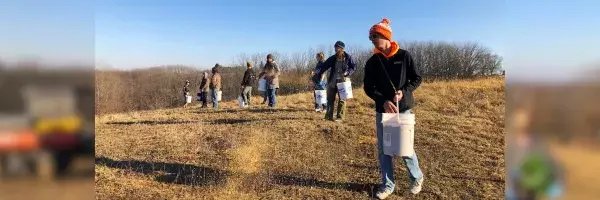Cultivating a legacy of sustainability and stewardship on St. Joseph Ridge

By Siena Muehlfeld, FSPA Land Sustainability Coordinator, and Maggie Schreiber, AmeriCorps Ecological Assistant
To the Franciscan Sisters of Perpetual Adoration, establishing a prairie is much more than a conservation effort. It is an opportunity to connect people to one another and to the environment. The sisters know that environmental health and human wellness are inseparable. Their commitment to integrating community, nature, education and public health is exemplified by their care of 200 acres of farm and forest land on St. Joseph Ridge east of La Crosse, Wisconsin. For decades this farm provided food for St. Rose Convent and St. Francis Hospital in La Crosse. Eventually, a portion of the land became Villa St. Joseph, a skilled-care retirement home for sisters through 2023.
Today the FSPA Land on St. Joseph Ridge is integral to the sisters’ mission which includes commitment to the seven-year Laudato Si’ Action Platform — intensifying actions for greater social and environmental justice. FSPA’s steadfast stewardship and sharing of this special place is an example of what it means to care for creation. FSPA employs a land sustainability team that protects, enhances and restores the property and its native biodiversity on behalf of the sisters. The sisters recognize that the land they occupy is traditional to and unceded by the Ho-Chunk peoples. FSPA is committed to learning from and working with local Indigenous communities to forward FSPA’s commitment to Truth and Healing and building a healthier future.
Recently the FSPA land team has been focused on prairie restoration with priority given to a new, 2.1-acre prairie planting located next to three hermitages managed by FSPA’s Franciscan Spirituality Center. This site used to be a productive orchard run by the sisters, so it’s now known as the “old orchard.” In 2021 FSPA decided to convert this area to a native prairie habitat to benefit pollinators, improve biodiversity, build topsoil, reduce erosion and improve rainwater filtering.
FSPA received funding and technical support for this project through the USDA’s Natural Resource Conservation Service. The prairie was planted in spring 2022, but there were a few unexpected issues. A different planting method was used than the one the seed mix was designed for, so not enough seeds were sowed on site. Also, a heavy rainstorm washed many seeds downhill and off the prairie soon after planting. Equipment issues limited the FSPA team’s ability to mow the site in its first year. Each of these setbacks offered an opportunity for fast-growing weeds to outcompete the young prairie plants and take over the project area, so intervention was needed on behalf of the prairie.
The planting was evaluated by an NRCS specialist in late summer 2023. NRCS identified several young prairie plants plus significant weed pressure. Luckily, most weeds were tall enough to control with mowing, and areas of bare soil were found throughout where new prairie plants could grow. NRCS provided hope that with strategic mowing, the planting could still be well established, and said that chances would improve with more prairie seed added. The team decided to move forward with sowing more seeds that fall to give the prairie its best chance.
The team had much to do to prepare for the fall 2023 seeding. We reached out to local partners for guidance and ordered an improved seed mix designed for hand broadcast — distributed by hand. We also gathered supplies, hoping to repurpose as much as possible. We found a free supply of sawdust from a local sawmill for use as a carrier material, several recycled 55-gallon barrels for storage and five-gallon buckets to use for broadcasting the seeds.

To prepare the field for seeding, we used a drag harrow to scuff up the ground just enough to expose more soil and damage some of the shallow-rooted weeds. This method was gentle enough to protect healthy, young prairie plants and still-dormant prairie seeds from the original planting while also giving a head start for the new seeds.
We determined that one barrel of broadcast seeding mix would cover one-eighth of the field and so divided the prairie seeds into eight equal portions. To prepare the mix, we first needed to find the right water-to-sawdust ratio. The purpose of the sawdust carrier material is to spread the prairie seed mix evenly across a large area. The carrier mix couldn’t be too dry or too wet because the prairie seeds needed to adhere to it but not create clumps. We found that combining 45 gallons of sawdust, 1.5 gallons of water and one portion of prairie seeds worked best for our mix.
On seeding day, the FSPA land team was joined by sisters, affiliates, prayer partners and partners in mission on staff, as well as horticulture students from Western Technical College in La Crosse. It was perfect December weather — sunny and not too cold. We embodied the sisters’ love of community building by providing hot drinks and encouraging breaks for words of welcome and socializing.
For the project, one group of “mixers” combined the seeds, sawdust and water for each section. When a mix was ready, it was delivered to a group of broadcast seeders in the field. Each “seeder” loaded a bucket with mix and lined up along one edge of the section. Once in line, the person farthest uphill started sowing, and the rest followed gradually behind. This ensured each section was covered evenly. As the FSPA team worked alongside students and volunteers, a wealth of knowledge was shared and a great time was had by all.
Now that the seeds are sown, we must be patient. The prairie will be mowed, monitored and burned as needed in the next several years to guide it towards self- sufficiency. In the short term, the FSPA team is proud of hosting this opportunity for our community to come together and learn about restoring native prairie. There is nothing more rewarding than achieving something difficult together, especially when caring for Earth, our common home.
